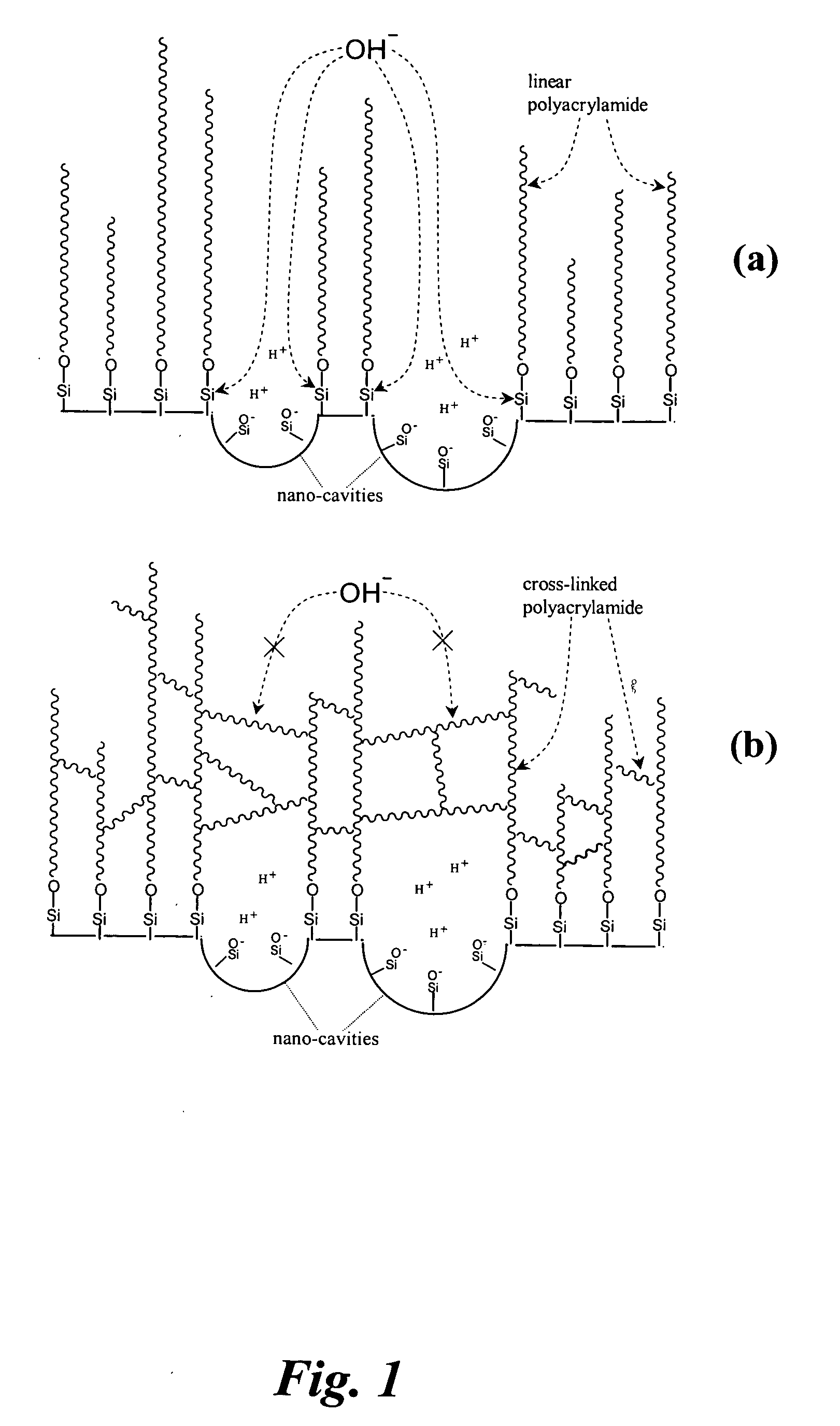Coatings for molecule transport and separations
a technology of molecule transport and separation, applied in the direction of coatings, pretreated surfaces, instruments, etc., can solve the problems of adsorption of protein molecules to the capillary walls, unfavorable electroosmotic flow (eof), and difficult separation of proteins by ce, so as to reduce the number of h2o molecules on the surface.
- Summary
- Abstract
- Description
- Claims
- Application Information
AI Technical Summary
Benefits of technology
Problems solved by technology
Method used
Image
Examples
example 1
[0055] Preparation of linear polyacrylamide (LPA) coating. Bare capillaries were first washed with 1 M NaOH for 45 min, ultra-pure water and acetonitrile for 15 min each, and then dried with helium. To attach the anchoring functional reagent to the capillary wall, a solution of 0.4% (v / v) of 3-(trimethoxysilyl)propyl methacrylate and 0.2% (v / v) acetic acid in acetonitrile was flushed into the capillaries with a syringe pump at 50 μl / min for 1 h. The capillaries were then rinsed with acetonitrile and dried with helium.
[0056]FIG. 2 presents a device to carry out the polymerization reaction to produce a cross-linked polymer layer on the capillary wall. A 2-mL vial containing 1 mL solution was covered by a septum and clamed together through two ¼-inch-thick acrylic plates. On the top acrylic plate, there were five 1-mm-diameter holes through which the septum was accessible. A small recess on the bottom acrylic plate was used to secure the vial in position. Helium gas was introduced to ...
example 2
[0058] Preparation of cross-linked polyacrylamide (CPA) coatings. The process is the same as described in Example 1, except that the vial in FIG. 2 contained 3-4% of acrylamide (AA) and 0.003-0.03% N,N′-methylene-bis-acrylamide (Bis), and the capillary tip was taken out of the polymerizing solution and quickly flushed with de-ionized water after the polymerizing solution was flushed through the capillary for 4 min, 6 min, 8 min, or 10 min.
example 3
[0059] CIEF Separations. The CIEF separations were performed using a capillary with a total length of 40 cm (an effective length of ca. 36 cm) and an inner diameter of 50 μm, unless otherwise indicated. 10 mM of phosphoric acid and 20 mM of sodium hydroxide were respectively used as anolyte and catholyte. The solution levels in the anolyte and catholyte reservoirs were carefully adjusted to be at the same height. Right before a CIEF separation, a protein sample was mixed with pharmalyte and diluted with water to make the final solution contain 1.8% (w / v) pharmalyte, 7 M urea and a desired amount of protein. After the CIEF capillary was filled with the above protein-pharmalyte mixture, isoelectric focusing was conducted by applying a voltage of 20 kV across the capillary for 20 min. The focused bands were hydrodynamically mobilized to the UV / V is detector after the anolyte reservoir was raised by 2.7 cm. The high voltage was kept on during the mobilization. Between runs, the anolyte ...
PUM
 Login to View More
Login to View More Abstract
Description
Claims
Application Information
 Login to View More
Login to View More - R&D
- Intellectual Property
- Life Sciences
- Materials
- Tech Scout
- Unparalleled Data Quality
- Higher Quality Content
- 60% Fewer Hallucinations
Browse by: Latest US Patents, China's latest patents, Technical Efficacy Thesaurus, Application Domain, Technology Topic, Popular Technical Reports.
© 2025 PatSnap. All rights reserved.Legal|Privacy policy|Modern Slavery Act Transparency Statement|Sitemap|About US| Contact US: help@patsnap.com



